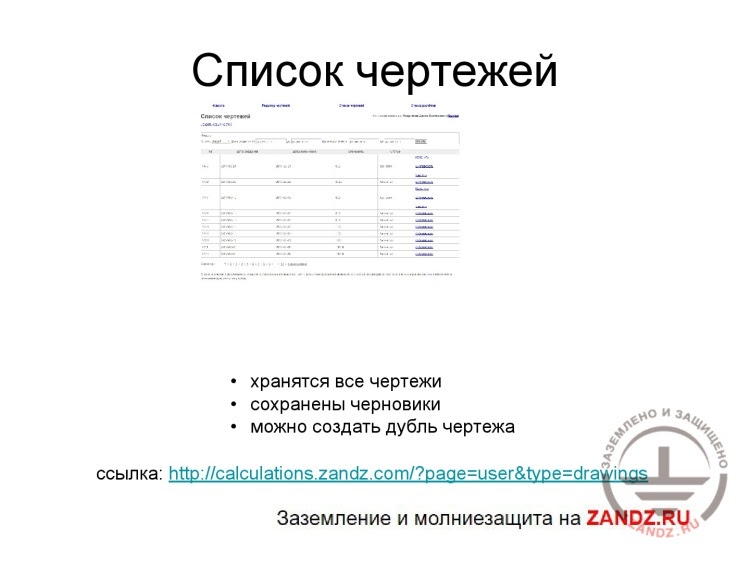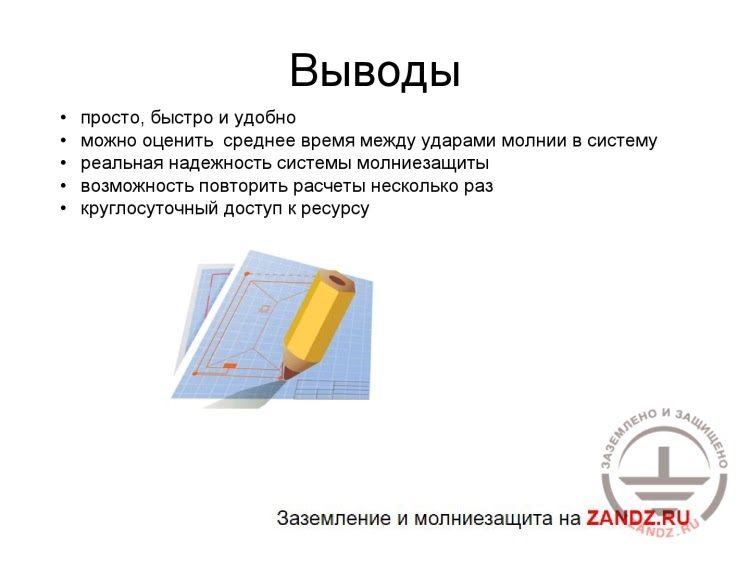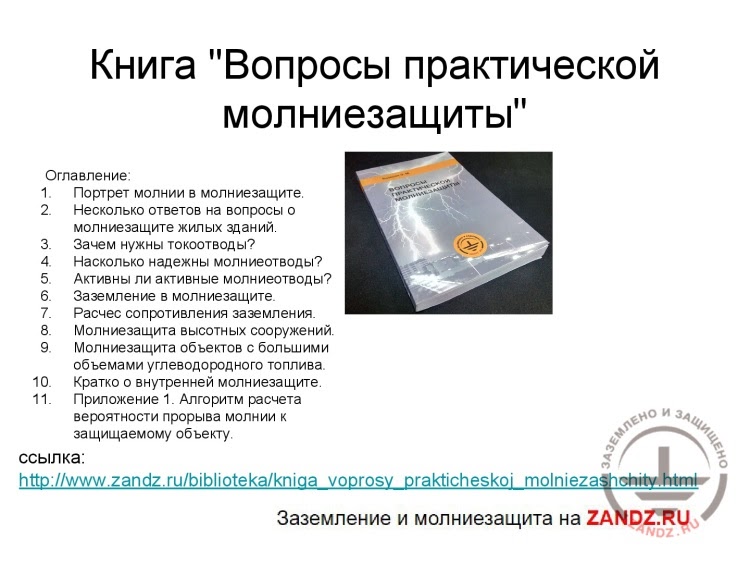|

"Drawings list" section
|
Список чертежей
|
Drawings list
|
|
Хранятся все чертежи
|
All drawings are saved
|
|
Сохранены черновики
|
Drafts are saved
|
|
Можно создать дубль чертежа
|
A drawing copy may be created
|
|
Ссылка:
|
Link:
|
|
Заземление и молниезащита на ZANDZ.COM
|
Earthing and lightning protection at ZANDZ.COM
|
– We have got one final, fourth section, left. It is a "Drawings list". If we access this section, we will see the following: we have got a serial number of calculation, creation/modification date. Please ignore the price yet. The service is free of charge because it is in the trial mode. So, we look at the status. It can be either "Calculated" or "Draft". It means that if we have got a drawing that we have entered and saved but did not calculate, it is not deleted but saved in the drawings list. The following functions are available: edit, duplicate, or delete. It means that we may duplicate or make some changes into the system, and so on; we can change it. If we have got a calculated drawing, it has the "Calculated" status, and we can only duplicate it: the copy is created, and we make some amendments into the system and perform the calculations again. It will be shown as a separate string.

Webinar results
|
Выводы
|
Conclusions
|
|
Просто, быстро и удобно
|
Simple, quick, and convenient
|
|
Можно оценить среднее время между ударами молнии в систему
|
An average time between lightning strikes into the system may be estimated
|
|
Реальная надежность системы молниезащиты
|
Actual reliability of the lightning protection system
|
|
Возможность повторить расчеты несколько раз
|
Ability to repeat calculations several times
|
|
Круглосуточный доступ к ресурсу
|
24/7 access to the service
|
– Let's proceed with the presentation. Summarizing, we can draw the following webinar conclusions. The service is fairly simple in use. It calculates the actual reliability of the lightning protection system using the statistical method, i.e. you obtain the particular values. You also obtain the information as the probability parameters for the lightning breakthroughs into the system and lightning strikes into the system in general. To perform an analysis and consider a technical solution that has probably been calculated in the design, you may check it and see how often your object is subjected to the direct lightning strikes. It is possible that this information will be very important for the customer, since, if a breakthrough occurs once in 10 years, but the facility is planned to be operated for not less than 50 years, then the customer may want to somehow improve the lightning protection system and change some decisions.

"Practical Lightning Protection Issues" book
|
Книга «Вопросы практической молниезащиты»
|
"Practical Lightning Protection Issues" book
|
|
Оглавление:
|
Table of Contents:
|
|
1. Портрет молнии в молниезащите.
|
1. A picture of lightning in lightning protection.
|
|
2. Несколько ответов на вопросы о молниезащите жилых зданий.
|
2. Several answers to the questions about the lightning protection of residential buildings.
|
|
3. Зачем нужны токоотводы?
|
3. Why do we need current collectors?
|
|
4. Насколько надежны молниеотводы?
|
4. How reliable are lightning arresters?
|
|
5. Активны ли активные молниеотводы?
|
5. Are active lightning arresters really active?
|
|
6. Заземление в молниезащите.
|
6. Earthing in lightning protection.
|
|
7. Расчет сопротивления молниезащиты.
|
7. Calculation of lightning protection resistance.
|
|
8. Молниезащита высотных сооружений.
|
8. Lightning protection of high-rise structures.
|
|
9. Молниезащита объектов с большими объемами углеводородного топлива.
|
9. Lightning protection of facilities with large volumes of hydrocarbon fuel.
|
|
10. Кратко о внутренней молниезащите.
|
10. Briefly about the internal lightning protection.
|
|
11. Приложение 1. Алгоритм расчета вероятности прорыва молнии к защищаемому объекту.
|
11. Appendix 1. Algorithm for calculation of the lightning breakthrough probability to the protected facility.
|
– As I have already said, this software core was developed on the basis of the statistical method. Eduard Meerovich Bazelyan described the algorithm of this calculation method in more details in his book titled "Practical Lightning Protection Issues". It was detailed there. I think we can finish with the main part. Thank you for attention! Let's proceed to the questions, if any.
Questions and answers
– Thank you, Denis! We had a question. Probably, other participants are also interested in it. Certainly, the webinar video will be published on the website after we process the recording. If you have missed something, wait for several days. We will send the video. Let's answer the questions. A comment from Artem regarding the absence of specific formulas that are used for calculations. I think we can say again, what calculations it is based on and where you can find it.
– Yes, indeed, our effective regulatory documents do not say a word about the actual reliability calculations. There are some formulas that are assigned to some particular reliability, if we are talking about document SO-153. But in the previous webinars, Eduard Meerovich conducted a good analysis and showed that these formulas do not always match the real conditions. This software, as I have already said, performs calculations using the statistical method. It was developed by Eduard Meerovich. We cannot discuss the calculation method in full. It is rather large, but in his book, Eduard Meerovich provides full algorithm of calculation of the lightning protection reliability. I think that we can look at it. Moreover, we have got links on our website in the "Regulatory documents" section, wherein the regulatory document is available, the guidelines for the protection zones calculation, RD 34.21.121. There is a brief description for simple systems, but it is described in more details in the book written by Eduard Meerovich. Therein, full algorithm of the statistical method is provided. If you have got some general questions, please send them to e-mail. It will take much time to discuss them now.
– Thank you. We had several questions regarding the software fee. Will this software be fee-based, when will it happen and what fee will be? I will answer them. For now, the software is free of charge. Use it in your designs, verify your designs. If you have got any comments regarding its improvement and updating, provide a feedback. We will make changes. We are ready to change interface, if it is necessary. Tell us about it. The next question. Sergey asked during the webinar, if he understood correctly that this suite was developed for reverse calculations? I mean, by changing the lightning arrester height, we can calculate the system reliability and compare it to the values in the regulatory documents?
– Thank you, Denis. The next question from Vasily: "Will the software take into account the terrain?"
– Look, about the terrain. Our software is designed, as we have mentioned earlier. We have got a conventional coordinate system using three coordinates, i.e. x, y, and z (height). So, if you perform calculations while considering the terrain, then in the facility description, you should consider the height by yourself. If your facility is located on a hill, and the hill is insufficiently high, then you have got one part at a height and the other part on the spiles; in this case, you just use the lower part as a zero point of the rectangle that delineates your house wall. It means that when you set the coordinates for your facility, you may consider the terrain. It means that you can delineate, take some additional 2 or 3 meters depending on the terrain where your facility is located. In the description, you may simply set the height and, correspondingly, consider the terrain during the facility description, i.e. you just add the height difference. Or describe the facility using two rectangles, if your facility is angled. These will be two rectangles, and, again, any shape may be created with these lines as we have already done it in case of the roof. It means that if you create a closed circuit using the line, it will describe some plane that will be considered as a facility to be protected.
– Question from Sergey: "How many facilities (buildings, structures) can be calculated in the software in one design?"
– Many facilities. As far as I know, there were up to a hundred of objects. The software could cope with it. In any case, it is a technical problem and it can be solved. If it will not be enough, the number of objects can be increased at any time. It is a technical problem that can be solved. I have not encountered the limitations in calculation. I entered one hundred objects, and the software could handle them.
– Kirill clarified: "Have you shown the solution created by your software to GlavGosExpertiza? Do they accept such variant?"
– Yes, we have had such cases and we have received feedback from the designers. They are considered because when the facilities are high-rise or of some complex configurations, we have got a direct reference to this software in the effective regulatory document, item 3.3.1 of SO-153. It clearly specifies what software must be used. When SO-153 was developed, there was no such software, but all these regulatory documents, SO and RD, have been developed with the participation of Eduard Meerovich, i.e. the Krzhizhanovsky Institute. And the computational core was created for this purpose. Therefore, it is not a problem. If the expert board does not accept it, you may directly refer to SO-153, item 3.3.1, and Technical Bulletin No. 25/2009, where it is clearly stated what software can be used. We have got all these regulatory documents in the section for designers. And Technical Bulletin and all of them are published on our website.
– Thank you, Denis. Sergey clarified: "It may happen that at some point the height of the lightning arrester may be insufficient for protection, but you will not be able to make it any higher."
– Thank you for the answer, Denis. Vasily clarifies if we plan to add the active lightning protection system into the software.
– The active lightning protection was discussed long ago. First, it is not described in any regulatory document, and it is likely that we will not have it. And the efficiency of this system is not proved. We had a separate webinar dedicated to the active lightning protection from Eduard Meerovich. There are no calculation methods. The active lightning protection is not considered as a protection method. As an option on the basis of passive systems... it can be calculated, and you can use the active lightning protection at your own risk, but you cannot justify it using any regulatory document; therefore, nobody will work with this. Anyway, it is not officially stated.
– Question from Ilya: "Is the system core similar to the software that has also been developed in cooperation with the Krzhizhanovsky Institute, or there are significant differences?"
– Let's say that I have no information about who developed this software. Probably it will be incorrect, from my side, to compare these two calculation services. This question may be sent to ENIN. You would better send it to us by e-mail. We will study the issue and provide you with the answer, so that we would not give you the wrong information.
– Good. Thank you, Denis. At this point, we finish our webinar. Thanks to all participants. I repeat, send the remaining questions to our mail. We will study them and answer. Thank you! Bye!
– Thank you, colleagues! Wish you all the best. See you soon!
|